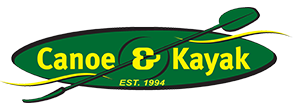
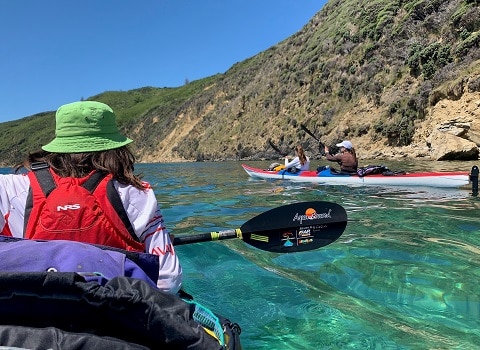
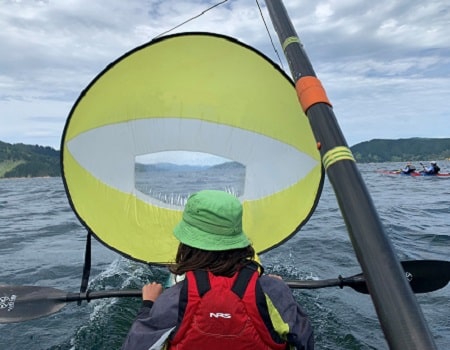

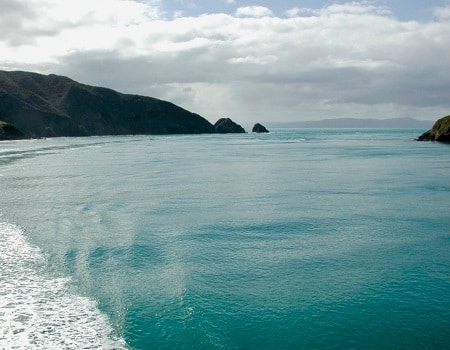
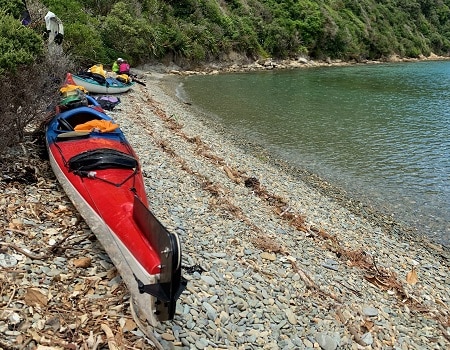
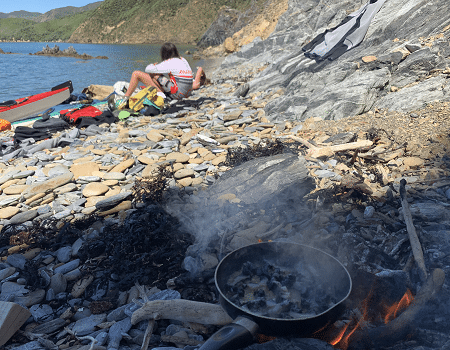
Time Out at Queen Charlotte Sound – Arapaoa Island
by Nathan Fa’avae
Queen Charlotte Sound is an incredible sea kayaking destination, that’s a fact. There is an infinite number of trips to do within the waterways, bays, beaches, coves, in and out, up and down the flooded valleys. What can easily go unnoticed is that much of the magic that Queen Charlotte offers is in fact provided by Arapaoa Island (formerly Arapawa): New Zealand’s 13th largest island, not much smaller than Waiheke.
At the head of Queen Charlotte, Arapaoa is positioned only one kilometre off the South Island to create Tory Channel, the sneaky little passage the ferries go through. The island itself is very narrow in places but it does a splendid job of giving shelter to the Sound and the interior islands (Blumine, Matapara Pickersgill, Long, and Motuara), aided largely because it climbs abruptly to 500 metres above sea level.
For the intrepid sea kayaker, Arapaoa Island has everything one could wish for, and I don’t say that lightly. For beginner sea kayakers cruising around the expansive East Bay provides sheltered waters and unlimited landing opportunities. There is one of the best DOC campsites in the entire Marlborough Sounds at Wharehunga. Being so close to the open sea, the nutrient-dense waters mean the marine and bird life is rich, and on fine days drifting over the reefs looking through pristine clear water, one can see shellfish, paua clinging to the rocks in the kelp beds, and it’s not difficult to spot blue cod feeding along the bottom. The snorkeling in Anatohia Bay is surprisingly good, with marine life you’d normally expect in warmer tropical waters. The fact that there is thriving salmon and mussel farms around the island is a testament to the environment. There are a few spots popular for seals, little blue penguins have nesting colonies on the island and there are nearly always dolphins around the island somewhere.
For the more confident paddlers, Tory Channel / Kuha Te Au, is a dynamic and engaging section of water. It pays to time the tidal flow to aid your progress, which is both fun and fascinating at the same time, with millions of litres [at a guess] of water being exchanged in the channel each tide, it’s a powerful place to be. There is a quaint little DOC campsite at Ngaruru Bay. If you’re a light sleeper then expect to be woken a few times during the night as the ferries chug on by. I quite like it, the ferries are a symbol of connection between the North and South Islands and play an important role in New Zealand life, they serve to remind you where you are as well – out on an adventure.
A somewhat sad but interesting place to visit is the historic Perano Whaling Station, close to the entrance to the Cook Strait. The framework of the factory still exists and there are detailed information panels to learn about what took place there. It is a sombre place but part of the history of the area and an insight into the time period the people lived in.
Within the channel, there are numerous side trips and places to explore, you can easily spend two to three days in the channel area itself, and if you want fish for dinner, you’re most likely not going to go hungry. When I was an Outward-Bound instructor many years ago, we nicknamed it Ara-paua Island.
For the advanced paddlers, there is a short but very committing open ocean leg from Perano Head to Cape Koamaru. With the mythical islands ‘The Brothers’ supervising, there is a 16 km paddle to reach shelter. There is no landing on the east side of Arapaoa and it’s very important to paddle with the tidal streams, which can be ripping like a river. If you got the tidal stream wrong, it’d be easier to paddle to the North Island, no joke.
Passing between West and East Head at the entrance to the Cook Strait, it’s an intelligent move to go through at slack water, the water hydraulics there can push the ferry around some days. If you’re lucky enough to have calm settled weather, the northwestern beaches are havens, between Te Huahua and Onehunga Bays. There are four to five lovely beaches to explore during the day, with brilliant swimming and snorkeling. To circumnavigate the island, prepare for a 60 to 70 km trip. Starting your trip, you can either paddle out to Arapaoa from Picton easily in a day or take a water taxi which can drop you and your kayaks on the island.
Whatever your paddling ability, Arapaoa Island offers an excellent multiday trip. If you are wanting some comfort, which I will admit having sought on some trips to the Island, the Homestead at Whekenui Bay is a prime destination with a variety of cosy accommodations. There is also a sea farm with Paua pearls to visit, plus a big sandy beach to enjoy. There is a very nice place to rent and base yourselves at Burneys Bay. So, between these places and your tent, you have a wide range of overnighting options.
Arapaoa provides a unique destination and theme for a sea kayak trip, it’s well worth the effort and highly worthy of whatever time you can give it.
